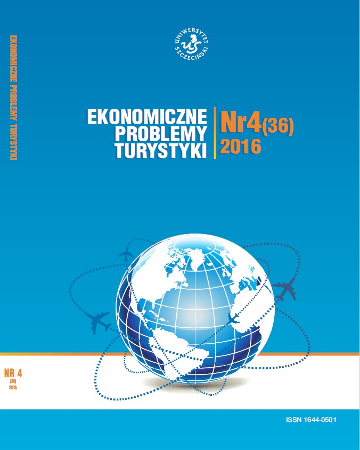
ISSN: 1644-0501
eISSN: 2353-3188
OAI



Issue archive /
nr 1 (29) 2015
Podstawy rozwoju geoturystyki na Wyspach Kanaryjskich ze szczególnym uwzględnieniem Lanzarote
(Development of Geotourism on the Canary Islands Case Study – Lanzarote Island)
| Authors: |
Izabela
Kapera
Akademia Wychowania Fizycznego w Krakowie Paweł Różycki Akademia Wychowania Fizycznego w Krakowie |
| Keywords: | Canary Islands Lanzarote geotourism |
| Data publikacji całości: | 2015 |
| Page range: | 18 (223-240) |
Abstract
The purpose of the paper is to analyze the development of geotourism on the Canary Islands, a region already focused on tourism in general, but also ideal for the pursuit of geotourism. Other issues analyzed in the paper include tourist volume and reasons for visiting the islands, which are often associated with recreational travel with their sunshine and beaches. Both goals are readily achieved in this region, and tourists flock to the islands in large numbers – more than 12 million in 2013. Visitors pursue sightseeing and other recreational opportunities available thanks to the Atlantic Ocean and local beaches. Some visitors also value sites and processes associated with the islands’ unique geology.The effects of the volcanic past of the Canary Islands can be observed everywhere. Tenerife Island is particularly valuable in this regard, with its highest peak, Pico del Teide (elevation: 3,718 m). Lanzarote Island is also quite valuable, with its Timanfaya National Park. While the island is attractive to tourists, it is also interesting from a purely scientific point of view for individuals studying volcanology. One indicator of how important the island is to geotourism is the planned creation of the Lanzarote and Chinijno Islands Geopark. The establishment of this park will likely make Lanzarote Island even more attractive to tourists, and will be a sign that the island is taking steps to develop sustainable tourism options.
Download file
Article file
Bibliography
| 1. | Application Dossier, Lanzarote and Chinijno Islands Geopark Project, 2013, ftp://ftp.unesco.org/upload/sc/GGN%20APPLICATIONS%202014/LANZAROTE/Application%20dossier.pdf. |
| 2. | Cruz C.M.G, The Origin of the Canary Islands. A Chronology of Ideas and Related Concepts, from the Antiquity to the End of 20th Century, INHIGEO (International Commission on the History of Geological Sciences), Sydney 2001. |
| 3. | Dóniz-Páez J., Guillén-Martín C., Romero-Ruiz C., Coello de La Plaza E., Geomorphosites, volcanism andgeotourism: the example of cinder cones of Canary Islands (Spain), w: Proceedings of the International Conference on Geoheritage and Geotourism, red. M. rodrigues, e. Freire, Associação Portuguesa de Geoturismo (APGeotur) centro de estudos Geográficos (ceG) of the Lisbon University, Lisbon 2010. |
| 4. | Dóniz-Páez J., Becerra-Ramírez R., González-Cárdenas E., Guillén-Martín C., Escobar-Lahoz E., Geomorphosites and Geotourism in Volcanic Landscape: the Example of La Corona del Lajial Cinder Cone (El Hierro, Canary Islands, Spain), GeoJournal of tourism and Geosites year iV” 2011, vol. 8, no. 2. |
| 5. | Dóniz-Páez J., Opiniones y ensayos. Reflexiones en torno al turismo volcánico. El caso de Islas Canarias, „PASOS. Revista de Turismo y Patrimonio Cultural” 2014, vol. 12, no. 2. |
| 6. | http://reddeparquesnacionales.mma.es/en/. |
| 7. | http://www.aemet.es/es/portada. |
| 8. | http://www.datosdelanzarote.com/. |
| 9. | http://www.gobiernodecanarias.org/presidencia/turismo/estadisticas_y_estudios/. |
| 10. | http://www.lanzarote-guide.com/en/. |
| 11. | Itinerarios didácticos por la isla de Lanzarote, Grupo de Investigación GEOVOL. Geomorfología, Territorio y Paisaje en Regiones Volcánicas. PATROCINAN. Universidad de Castilla-La Mancha, Facultad de Letras, Facultad de Letras, Departamento de Geografía y Orde- nación del territorio, ciudad real 2013, www.uclm.es/.../itinerarios%20Didácticos. pdf. |
| 12. | Kowalczyk A., Turystyka geologiczna (geoturystyka), w: Turystyka zrównoważona, red. A. Kowalczyk, PWN, Warszawa 2010. |
| 13. | Kowalczyk A., Zasoby przyrodnicze jako atrakcje kulturowe: przykłady z wyspy Lanzarote |
| 14. | (Hiszpania), „Turystyka Kulturowa” 2013, nr 5/2013, |
| 15. | http://turystykakulturowa.org/ojs/index.php/tk/article/view/211/197. |
| 16. | Maciejowski W., Z wyspy na wyspę (kanaryjską), w: Informator Polskiego Towarzystwa Geograficznego. Badania i podróże naukowe krakowskich geografów, red. Z. Górka, J. Więcław-Michniewska, PTG. Oddział w Krakowie, Kraków 2003. |
| 17. | Migoń P., Geoturystyka, PWN, Warszawa 2012. |
| 18. | Miskiewicz K., Doktor M., Słomka T., Naukowe podstawy geoturystyki – zarys problematyki, „Geoturystyka” 2007, nr 4(11). |
| 19. | Murphy. P., Wyspy Kanaryjskie, Wiedza i Życie, Warszawa 2003. |
| 20. | Teneryfa i Gomera, Pascal Sp. z o.o., Bielsko-Biała 2006. |
| 21. | Sigurdsson H., Lopes-Gautier R., Volcanoes and Tourism, w: Encyclopedia of Volcano, red. H. Sigurdsson, Academic Press, San Diego 2000. |
| 22. | Słomka T., Kicińska-Świderska A., Geoturystyka – podstawowe pojęcia, „Geoturystyka” 2004, nr 1(1). |
| 23. | Turystyka, red. W. Kurek, PWN, Warszawa 2007. |
| 24. | Volcanic Tourist Destinations, red. P. Erfurt-Cooper, Springer, Berlin–Heidelberg 2014. |
| 25. | Volcano & Geotermal Tourism. Sustainable geo-resources for Leisure and Recreation, red. P. Erfurt-Cooper, M. Cooper, Earthscan, London–Washington 2010. |